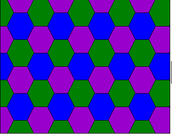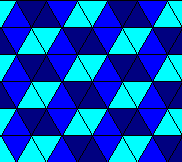To most people the common perception of maths is it being never ended pages of addition, subtraction, multiplication and division sums, so imagine maths being taught creatively? Yes, I was surprised at this thought too. Personally, I am a very creative person and have a strong love for art, so I find the possibility of art being applied to maths very intriguing.
During one of the workshops in Discovering Maths, we were introduced to the concept of maths being taught through tessellations. Harris (2000) defines tessellation as “the covering of a surface with a repeating unit consisting of one or more shapes in such a way that there are no spaces between, and no overlapping of shapes.” Tessellation is often poorly taught in classrooms as its often used as a colouring in exercise. This leads to little progression as the children do not understand why some combinations of shapes tessellate and others do not (Harris, 2000). Haylock (2014) states “for children to enjoy learning mathematics it is essential that they should understand it; that they should make sense of what they are doing in the subject, and not just learn to reproduce learnt procedures and recipes that are low in meaningfulness and purposefulness.” This links to Ma (2010) Profound Understand of Fundamental Mathematics through the ‘Basic Concept’. The children must firstly have a strong understanding of their 2-Dimensional shapes e.g. Quadrilateral, Polygon, Regular, Irregular etc. It is by learning these shapes and their properties children can learn which shapes tessellate, which do not and why. This can be done through using templates. They should discover that the only three shapes that fit together without any gaps are a square, hexagon and an equilateral triangle. This is due to the angle they make where the vertices touch = 360 degrees, linking to Ma’s principle of ‘Longitudinal Coherence’. The children are using the basic concept of shape and are applying this knowledge to explain more complicated concepts, (Ma, 2010). Showing the children how tessellation is applied in the real world, such as wall and floor tiling, demonstrates the value and purpose of understanding the mathematics they are being taught. Resulting in deeper engagement, according to Harris (2000).



We also explored how children’s knowledge of 2D shapes can be developed through paper folding. It is important for the adult to be reinforcing the mathematical language associated with shapes, for example, sides, angles and symmetry.
This is an example of paper folded shapes.

Digital root circles are another creative activity that can be used in the primary school. Digital roots provide good opportunities for children to find and create visual patterns. They also strengthen the children’s knowledge of their multiplication tables. The activity starts with the children working out the digital roots of the numbers in each of the multiplication tables, starting with the one times table, and progressing to the twelve times table. This creates a more enjoyable way of learning the dreaded time’s table.
Example
5 x 3 = 15
1 + 5 = 6
So the digital root is 6. Here are some examples, I have done from finding out the digital root:

By doing more creative activities like these maths has the potential to be an intriguing and exciting subject to learn. We as teachers can hopefully change children’s outlook on maths through more creative and stimulating lessons. It is vital as teachers to have a clear understanding of the underlying structure of the mathematics being learnt to provide the best learning opportunities for our pupils, through promoting understanding and confidence in mathematics. We must also develop our pupils understanding through exploration, problems solving, discussion and practical experience according to Haylock (2014).
So to answer the question, yes maths can be taught creatively!.
References
Ma, L. (2010) Knowing and Teaching Elementary Mathematics – Teachers’ Understanding of Fundamental Mathematics in China and The United States.London: Routledge
Harris, A. (2000) The Mathematics of Tessellation. [Online]. Available at:https://my.dundee.ac.uk/bbcswebdav/pid-5217937-dt-content-rid-3675302_2/courses/ED21006_SEM0000_1819/Tessellation.pdf
Haylock, D. (2014) Mathematics explained for primary teachers, 5th edn.,: SAGE.
